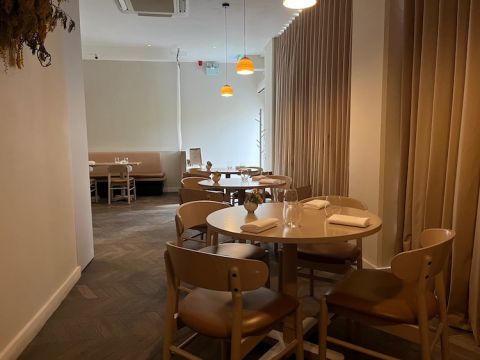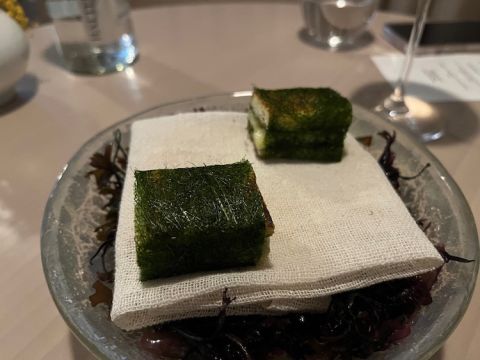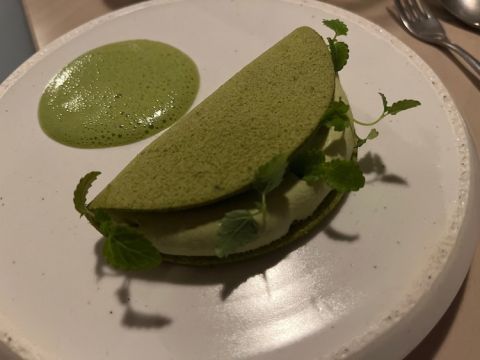Never underestimate the influence of a properly made baguette.
That is the only conclusion I can draw from an excellent, set-menu dinner at the Korean restaurant Sollip near London Bridge and an extremely enjoyable hour subsequently spent with its chef and owner, Woongchul Park, pictured above.
It was over a dim sum lunch in Chinatown, which Park, I have to admit, ate far more adroitly than I did, that I learnt of the far-reaching effects of the baguette. Park was 13 and growing up in Korea when he first fell under the influence of the bread and patisserie made by Paris Baguette, a chain with branches worldwide. Turning his back on rice, fish and the appetising pickles that constitute traditional Korean breakfast fare, this very French breakfast was to set Park off on a career as a chef.
It was a long and convoluted journey that would lead Park, now 38, to open Sollip ('pine needles' in Korean), in August 2020. By this time he was married, to Bomee Ki, a pastry chef. They have a nine-year-old son and a seven-year-old daughter, and such success as the couple have enjoyed has ramifications 9,000 kilometres away.
Park came to London to train at Le Cordon Bleu before numerous stints in various top French restaurants in the UK and US before returning to Korea. There he initially consulted with Ki before they fell in love and got married. But they set their hearts on opening in London and in 2019 Park returned alone, charged with finding a location for their restaurant and a home, ideally close by.
He managed to pull off both, finding a former cafe/tapas bar and an apartment not too far away. His timing, because of the pandemic, was less good but Park was philosophical about this period. ‘Everybody was in the same situation and it did give me extra time with the children’, he explained with a smile. It also gave them time to experiment, to eventually substitute their initial à la carte menu for a set dinner menu at a time when they realised their customers might not want to spend too long in any new restaurant.
This approach, and their combined skills, won the restaurant a Michelin star last year, an award that brings a smile to Park’s face as he mentions it. But this recognition has had more far-reaching consequences than the predictable waiting list for tables and an increase (if still not a large enough one) in resumés from interested chefs. Most importantly, the Michelin star has delighted both sets of parents, who initially had doubts about the London scheme.
Woongchul’s elder brother is an eminent heart surgeon. When Woongchul decided to become a chef, he was taking a step into what he calls ‘the professional unknown’ before he took the physical one of setting off for London in search of a new home. Only Bomee’s mother has been to London so far, on three separate occasions, each one to help look after her grandchildren. Park hopes to cook for his parents and parents-in-law one day but in the interim the star has calmed their fears somewhat.
All this background helps, I hope, to explain the determination that lies behind the cooking on offer at Sollip, and also that in some ways it has a split location – on the outside very London, on the interior extremely Korean.
When you walk out of London Bridge station in the shadow of The Shard, the setting has to be London, an emotion reinforced when turning into Melior Street with the outline of a multi-storey lift shaft being built to service some future office building. Once inside Sollip, which backs on to another fine restaurant, Trivet, the feeling is very different: the colours are muted; the tables are bare of everything except napkins and water glasses; and the windows have floor-to-ceiling curtains. The cumulative effect, as the woman on the next table succinctly put it, is ‘soothing’.
The service, as one would expect in a restaurant that can seat 28 maximum, is efficient and extremely friendly. We were each given a copy of that night’s menu and the wine list which includes several not-too-expensive but quite young red burgundies and a fascinating wine pairing suggestion that offers six exciting wines for £87. This we chose, asking the young wine waiter, Filippo from Genoa, to split the wines into two half-pours apiece for us.
All the wines come via Keeling Andrew, the import business associated with Noble Rot, and a friendship Park has established with Noble Rot’s Master of Wine Mark Andrew in particular. The wines were all obviously chosen on the basis of having tasted his food: an appetising 2017 champagne from Michel Gonet; a refreshing 2018 Riesling trocken from Müller-Ruprecht in the Pfalz; and perhaps best of all an exciting 2020 Savagnin from Château d’Arlay in the Jura that went extremely well with the skate dish. Only the 2018 Barolo from Trediberri was a slight disappointment, a little too sweet.
The menu (which changes several times a year although Park acknowledged the difficulties climate change will present) encompasses three languages – English, French and Korean – and several ingredients that from the outset set an adventurous tone. We began with a mouthful of fermented rhubarb; an exquisite tart topped with beef tartare; and a warm cheese sandwich wrapped in gamtae, a green seaweed especially imported from Korea, shown below.
The main menu consisted of eight small courses at £135 a head. They were so good and served with such aplomb that, unlike some multi-course meals, it didn’t seem a tedious marathon at all. The first was a courgette flower stuffed with crab meat and tofu in a warming crab broth, followed by a ‘tarte tatin’ in which the apples were replaced by thin slices of daikon and potato – a beautifully presented dish. There was a short intermission while we were each served a slice of sourdough bread made from scorched rice served with a delicious dried kelp butter.
The skate dish followed, highlighted by the romesco sauce served with a kimchi of mustard greens, and then a couple of pieces of lovingly cooked lamb, an ingredient that was for me overshadowed by the delicious sauce made from haggis that topped the accompanying bowl of rice shown above.
Of the three desserts, the green ssuk sand shown above was the most intricate but we both lost our hearts to the black sesame madeleines below.
For all this, I paid a bill of £406.69 for the two of us, including service for a meal that had been fascinating for the technique on show and also for the individuality of its approach.
To discover more about the latter, I sat down with Park over that lunch in Chinatown. I found him to have all the attributes of a talented young chef – pride in his background, a huge respect for the many ingredients he handles and, above all, a singular modesty in all that he has achieved.
But that would be slightly to misrepresent him. From the outset, he wanted to make clear how much of his success he owed to his wife. ‘I owe her an awful lot’, he explained. ‘Bomee was instrumental in our coming here and the design of the restaurant is down to her. And we both worked 20 hours a day at the beginning. And I do believe that the dessert, the final course, is extremely important as that tends to be what the customer remembers after they have left, and that is all her work.’ He urged me, ‘you must come back when our pain perdu is the dessert because that and the Korean black-bean ice cream make a fabulous combination.’
And while he thanked me for my compliments, he remained aware of the need to improve. ‘I don’t believe that customers want heaviness when they come out to eat and my role is, I believe, to refine our dishes even more, to make them lighter’, he told me. He laughed when I mentioned the unforgettable phrase of the late Mies van der Rohe that ‘less is more’. ‘Yes,’ Park smiled, ‘that is what I would like, too’.
Sollip Unit 1, 8 Melior Street, London SE1 3QP; tel: +44 (0)20 7378 1742


















